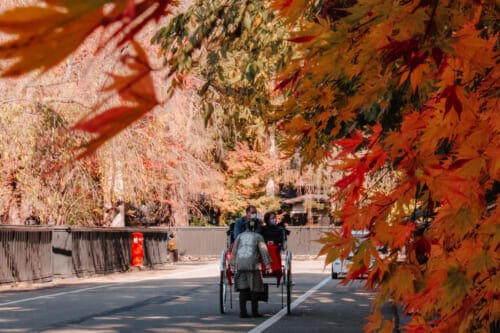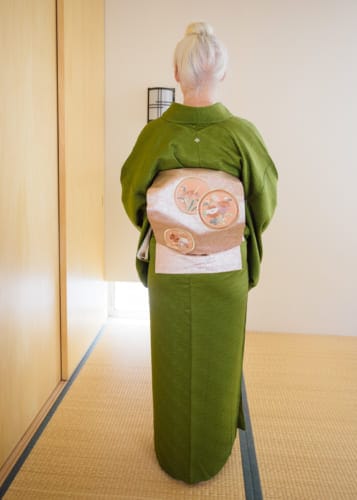Sponsored by the Shizuoka Prefecture Tourism Association
We continue our journey across Shizuoka at the same place we left off in our last article: Mishima. Our next destination? The beautiful Fujinomiya.
JR Mishima Station is a piece of art in itself. Those of you who enjoy anything train-related will definitely be charmed by Mishima. The roof over the tracks still maintains part of its original wooden framework.
The station alone is well worth a visit. Morover, we were welcomed by a nice change in weather, which made the trip even better. This was especially great, considering how gloomy it was back in Shuzenji Onsen. A Tokaido line train ride, while always charming, is most delightful on a clear day for a very particular reason, as you can see in the following picture.

Next stop: Fujinomiya
Once at Fuji Station, we changed trains and boarded the JR Minobu line. It is only a 20-minute ride to Fujinomiya from there. Upon arrival, which was early in the morning, we decided to walk around the area a little bit before checking into our hotel, where we would ultimately spend the night.
We quickly ran into an old shotengai, as you can see in the previous picture. Due to the mall-building boom taking place everywhere in the country, these traditional Japanese streets are now in decline. Though quite outdated, these neighborhoods still maintain a unique kind of charm which those of you who—like myself— who grew up in the ’80s, probably love and cherish. It is the same unique kitsch decadence that makes downtown Osaka a place like no other for many tourists.
The next shotengai we saw on our walk was more contemporary and crafts-oriented, with a few renovated shops scattered here and there. Next to the shotengai you will see the huge lanterns often found at the entrance to Japanese sacred areas. Without hesitation, we walked right in.
Fujisan Hongū Sengen Taisha Shrine
Sengen Taisha is Mount Fuji’s head Shinto shrine. Once inside, we found ourselves incapable of looking away from Fujisan, the real protagonist of the entire area. As we all know, Shinto is a religion based on worshipping nature, so it was a matter of time for Mount Fuji to become a cult item. The huge area surrounding the shrine is crammed with all kinds of interesting details. We will focus on just a small selection of them.
The statue of the horse archer reminds us of yabusame—a traditional type of Japanese mounted archery. In fact, once a year, a yabusame exhibition takes place in this very place for the visitors’ viewing pleasure. Not too far from here is the shrine’s main pavilion. Judging from its clear, lively colors, we assumed it must have been renovated not too long ago. Additionally, there are many attractive details on its colorful surface to keep you entertained.
Hidden behind the pavilion is a cute little pond that caught our eye.
Wakutama-ike
Geologists say that a lava tongue originally formed in Mount Fuji and quickly hardened due to a process of solidification can be found in this area. Covered in ashes and other porous volcanic waste, this lava tongue evolved into an impermeable stratum that now serves as a subterranean course, collecting rainwater and melted mountain ice. The little Wakutama pond, that we mentioned before emerged right where the course surfaces. Water discharged by the pond ended up turning into the Kanda River, whose course shapes Fujinomiya.
Who wants some soba?
As the sun sets, it is time for us to find a nice place to have dinner at. Preferably, somewhere we can try Fujinomiya’s specialty yakisoba. As we already mentioned in our previous article about Shuzenji, soba is one of Shizuoka’s signature dishes. Fujinomiya-style yakisoba is a very unique soba dish unlike any other in Japan. Pan-fried chewy noodles sprinkled with mackerel or sardine furikake and topped with pieces of crispy meat give it a very distinct texture and flavor.
Luckily for me, I did not have to do any research whatsoever; Fujinomiya’s tourism organization made that decision on my behalf. I am very grateful to Mr. Inagaki and Ms. Ando for taking care of me that night: 稲垣さん、安藤さん、心から感謝いたします。And, most importantly, I want to thank them for taking me to the splendid Toshian soba restaurant.
Other than the delicious menu it offers, Toshian stands out from other restaurants due to its lovely decor, which features local artwork and a wonderful tableware. It is in a rather inconvenient location, on a steep hill deep in the suburbs, making it a hidden treasure not often discovered by any tourists. You would not just casually run into it, so you will need clear directions in order to get there.
Toshian’s owner and head chef, Mr. Saito, is ultimately what makes this place special. Even though the restaurant was supposed to be closed that day, Mr. Saito came over to greet me and opened the restaurant just for me so I was able to enjoy a nice, private evening at Toshian. I want to advertise how wonderful the experience was. Being able to try his exquisite creations was a real pleasure.
A very special dinner
I was surprised to learn just how many possibilities buckwheat (soba) can offer when it comes to cooking it. Mr. Saito does not rely on your typical noodles. He goes far beyond that, as you can see in the following picture:
Fluffy soba dough with wasabi; whole wheat noodles; tonjiru (‘pork soup’) – with soba extract; soba-infused matcha (‘green tea’); kushidango (‘Japanese dumpling’) with soba and sweet sesame sauce: these are just some of the many dishes we were able to try at Toshian.
Rather than just chewing and swallowing, our dinner was a true soba-making master class. Mr. Saito explained to us (in gentle, very easy-to-follow Japanese) how peculiar and unique each recipe is. We also had the opportunity to take a look at both his kitchen and his soba workshop, which could be described as a small sanctuary with hard working conditions.
Soba must be kneaded in cold temperatures in order to avoid humidity loss in the room. Those of you who are especially sensitive to the cold should definitely stay away. Putting the cold temperature aside, I was also deeply impressed by the solid wooden bowl and the huge knife used for shaping and cutting soba (which, unfortunately, I could not photograph). These thins soba noodles are manually cut with sharp precision!

Each one of Toshian’s pieces is exclusive. In fact, some of them are quite old. When they break, Mr. Saito fixes them by using the ancient kintsugi technique—the art of filling cracks with gold.
A good night’s rest at Ogawaso Ryokan
Finally, it is time for some rest. That night I had the pleasure of staying at Fujinomiya’s Ogawaso Ryokan—a traditional hotel with rotemburo. Most ryokans in Japan are equipped with traditional tatami floors, futons and hot springs. Rotemburo is the word used for outdoor tubs, which allows you to take in the beautiful scenery while you bath.

A warm bath before bedtime always assures a good night’s sleep. Be sure to remember that rotemburos are often shared with other guests. Ogawaso is no exception, but it does allow visitors to shut the door for it to be enjoyed privately or with friends and family. You must first take a shower before sinking your feet in the bathtub. Once you are done, you will find a yukata—a light kimono—free for you to sleep in.
Some of you might wonder why would anyone ever want to take a bath outdoors in freezing February…up in the mountains….at night! But you will not really question it once you’re in Ogawaso. There is a magnetic presence in the background you can always see and sense, even when it is dark, which keeps pulling you into the rotemburo just so you can enjoy the view once more. See it for yourself:
See you around, Fujinomiya
I started off the day the right way, but I still needed a little push to get me through the rest of my trip. The chef gave me exactly what I needed: breakfast served in my room… and it was just as delicious as it looks.
Grilled fish, boiled veggies, pickles, miso soup, fantastic tea and rice—a traditional Japanese menu in a traditional Japanese room. It cannot get any better than this!
I checked out of Ogawaso feeling so grateful and happy. Now, off to the train station! There are many stops on our route that we will share with you shortly. Next time, we will ride a very special train. Stay tuned for our new posts!
Original article by José Montaño
Translated by Virginia González
SHIZUOKA GUIDE
Need more information? You can find up to date information about Shizuoka’s history, sightseeing locations, accommodation, food, and transportation by clicking on the link below:
https://shizuoka-guide.com/english/


























No Comments yet!